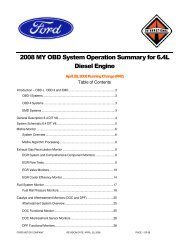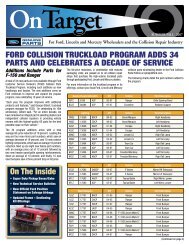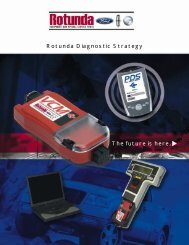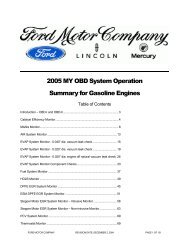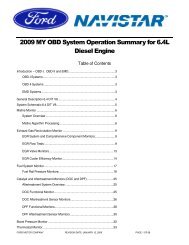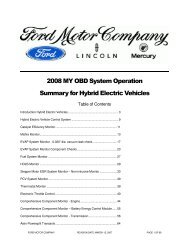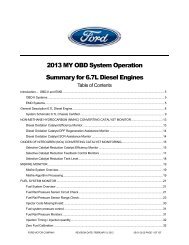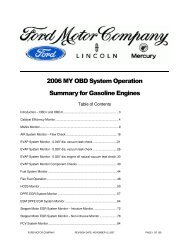2005 MY OBD System Operation Summary for Gasoline Engines
2005 MY OBD System Operation Summary for Gasoline Engines
2005 MY OBD System Operation Summary for Gasoline Engines
You also want an ePaper? Increase the reach of your titles
YUMPU automatically turns print PDFs into web optimized ePapers that Google loves.
!The Catalyst Efficiency Monitor uses an oxygen sensor be<strong>for</strong>e and after the catalyst to infer the hydrocarbonefficiency based on oxygen storage capacity of the ceria and precious metals in the washcoat. Under normal,closed-loop fuel conditions, high efficiency catalysts have significant oxygen storage. This makes the switchingfrequency of the rear HO2S very slow and reduces the amplitude of those switches as compared to the switchingfrequency and amplitude of the front HO2S. As catalyst efficiency deteriorates due to thermal and/or chemicaldeterioration, its ability to store oxygen declines. The post-catalyst HO2S signal begins to switch more rapidly withincreasing amplitude, approaching the switching frequency and amplitude of the pre-catalyst HO2S. Thepredominant failure mode <strong>for</strong> high mileage catalysts is chemical deterioration (phosphorus deposition on the frontbrick of the catalyst), not thermal deterioration.All applications utilize an FTP-based (Federal Test Procedure) catalyst monitor. This simply means that thecatalyst monitor must run during a standard FTP emission test as opposed to the 20-second steady-state catalystmonitor used in 1994 through some 1996 vehicles. Two slightly different versions of the catalyst monitor are used<strong>for</strong> 2001 <strong>MY</strong> and beyond vehicles. Both versions will continue to be used in subsequent model years." #$#%&''( )In order to assess catalyst oxygen storage, the monitor counts front and rear HO2S switches during part-throttle,closed-loop fuel conditions after the engine is warmed-up and inferred catalyst temperature is within limits. Frontswitches are accumulated in up to nine different air mass regions or cells although 3 air mass regions is typical.Rear switches are counted in a single cell <strong>for</strong> all air mass regions. When the required number of front switches hasaccumulated in each cell (air mass region), the total number of rear switches is divided by the total number of frontswitches to compute a switch ratio. A switch ratio near 0.0 indicates high oxygen storage capacity, hence high HCefficiency. A switch ratio near 1.0 indicates low oxygen storage capacity, hence low HC efficiency. If the actualswitch ratio exceeds the threshold switch ratio, the catalyst is considered failed.*$#%&+)In order to assess catalyst oxygen storage, the catalyst monitor counts front HO2S switches during part-throttle,closed-loop fuel conditions after the engine is warmed-up and inferred catalyst temperature is within limits. Frontswitches are accumulated in up to three different air mass regions or cells. While catalyst monitoring entryconditions are being met, the front and rear HO2S signal lengths are continually being calculated. When therequired number of front switches has accumulated in each cell (air mass region), the total signal length of the rearHO2S is divided by the total signal length of front HO2S to compute a catalyst index ratio. An index ratio near 0.0indicates high oxygen storage capacity, hence high HC efficiency. An index ratio near 1.0 indicates low oxygenstorage capacity, hence low HC efficiency. If the actual index ratio exceeds the threshold index ratio, the catalyst isconsidered failed.!If the catalyst monitor does not complete during a particular driving cycle, the already-accumulated switch/signallengthdata is retained in Keep Alive Memory and is used during the next driving cycle to allow the catalyst monitora better opportunity to complete, even under short or transient driving conditions.Rear HO2S sensors can be located in various ways to monitor different kinds of exhaust systems. In-line enginesand many V-engines are monitored by individual bank. A rear HO2S sensor is used along with the front, fuelcontrolHO2S sensor <strong>for</strong> each bank. Two sensors are used on an in-line engine; four sensors are used on a V-engine. Some V-engines have exhaust banks that combine into a single underbody catalyst. These systems arereferred to as Y-pipe systems. They use only one rear HO2S sensor along with the two front, fuel-control HO2Ssensors. Y-pipe system use three sensors in all. For Y-pipe systems, the two front HO2S sensor signals arecombined by the software to infer what the HO2S signal would have been in front of the monitored catalyst. Theinferred front HO2S signal and the actual single, rear HO2S signal is then used to calculate the switch ratio.FORD MOTOR COMPANY REVISION DATE: APRIL 28, 2004 PAGE 4 OF 131



